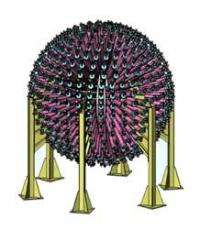August 4, 2009 weblog
Low-Budget Fusion Reactor Could Generate Energy within a Decade

(PhysOrg.com) -- Currently, most nuclear fusion power plants are large, expensive projects that will take decades to benefit from. But a startup company in Vancouver, Canada, called General Fusion is taking the fast track to fusion, with a plan to build a working prototype fusion power plant within the next decade at a cost of less than a billion dollars.
General Fusion has recently raised enough financial support - $13.5 million - from public and private investors to start the project. Rather than using expensive superconducting magnets (tokamaks) like the $14-billion ITER project in France or powerful lasers like those used by the Lawrence Livermore National Laboratory in the US, General Fusion plans to try a relatively low-tech approach called magnetized target fusion.
The reactor consists of a metal sphere with a diameter of three meters. Inside the sphere, a liquid mixture of lithium and lead spins to create a vortex with a vertical cavity in the center. Then, the researchers inject two donut-shaped plasma rings called spheromaks into the top and bottom of the vertical cavity - like "blowing smoke rings at each other," explains Doug Richardson, chief executive of General Fusion.
The last step is mainly well-timed brute mechanical force. 220 pneumatically controlled pistons on the outer surface of the sphere are programmed to simultaneously ram the surface of the sphere one time per second. This force sends an acoustic wave through the spinning liquid that becomes a shock wave when it reaches the spheromaks in the center, triggering a fusion burst. Specifically, the plasma's hydrogen isotopes - deuterium and tritium - fuse into helium, releasing neutrons that are trapped by the lithium and lead mixture. The neutrons cause the liquid to heat up, and the heat is extracted through a heat exchanger. Part of the resulting heat is used to make steam to spin a turbine for power generation, while the rest goes back to recharge the pistons.
The biggest challenge with the design will likely be showing that the technique actually works; no one has ever demonstrated that spheromaks can be compressed enough - while maintaining their donut shape - to create fusion. The design also takes advantage of digital control technologies that have only recently been developed, which are required to ensure that all 220 pistons strike the sphere at once.
General Fusion has just started developing simulations of the project, and hopes to build a test reactor and demonstrate net gain within five years. If everything goes according to plan, they will then build a 100-megawatt prototype reactor to be finished five years after that, which would cost an estimated $500 million.
According to fusion experts interviewed in MIT Technology Review, the design will likely face many challenges, but the idea is scientifically sound. As Ken Fowler, professor emeritus of nuclear engineering and plasma physics at the University of California, Berkeley, explained, the culture of a private startup might enable the process to proceed more quickly, with less worry about potential risks.
© 2009 PhysOrg.com

















